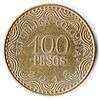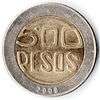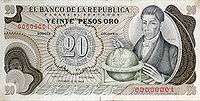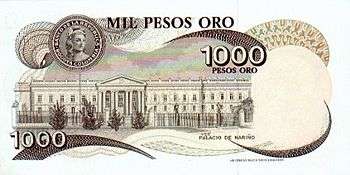Colombian peso
| Colombian peso | |
|---|---|
| peso colombiano (Spanish) | |
|
100,000 pesos | |
| ISO 4217 | |
| Code | COP |
| Denominations | |
| Symbol | $ |
| Banknotes | 1,000, 2,000, 5,000, 10,000, 20,000, 50,000, 100,000 pesos |
| Coins | |
| Freq. used | 50, 100, 200, 500, 1000 pesos |
| Rarely used | 20 pesos |
| Demographics | |
| User(s) |
|
| Issuance | |
| Central bank | Banco de la República |
| Website |
www |
| Valuation | |
| Inflation | 7.90% |
The peso is the currency of Colombia. Its ISO 4217 code is COP and it is also informally abbreviated as COL$. However, the official peso symbol is $. As of August 21, 2016, the exchange rate of the Colombian peso is 2,857 Colombian pesos to 1 U.S. dollar.
History
The peso has been the currency of Colombia since 1810. It replaced the real at a rate of 1 peso = 8 reales and was initially subdivided into 8 reales. In 1847, Colombia decimalized and the peso was subdivided into ten reales, each of 10 décimos de reales. The real was renamed the decimo in 1853, although the last reales were struck in 1880. The current system of 100 centavos to the peso was first used in 1819 on early banknotes but did not reappear until the early 1860s on banknotes and was not used on the coinage until 1872.
In 1871, Colombia went on the gold standard, pegging the peso to the French franc at a rate of 1 peso = 5 francs. This peg only lasted until 1886. From 1888, printing press inflation caused Colombia's paper money (pegged to the British pound at a rate of 5 pesos = 1 pound) to depreciate and the exchange rate between coins and paper money was fixed at 100 peso moneda corriente = 1 coinage peso. Between 1907 and 1914, coins were issued denominated in "peso p/m", equal to paper pesos. In 1910, the Junta de Conversión began issuing paper money and, in 1915, a new paper currency was introduced, the peso oro. This was equal to the coinage peso and replaced the old peso notes at a rate of 100 old paper pesos = 1 peso oro. In 1931, when the U.K. left the gold standard, Colombia shifted its peg to the U.S. dollar, at a rate of 1.05 pesos = 1 dollar, a slight devaluation from its previous peg.
Although it never appeared on coins, Colombia's paper money continued to be issued denominated in peso oro until 1993, when the word oro was dropped. Since 2001, the Colombian senate has debated whether to redenominate the currency by introducing a new peso worth 1000 old pesos, in other words, to remove three zeroes from the value. Such a plan has yet to be adopted.
Coins
Between 1837 and 1839, the Republic of New Grenada introduced silver ¼, ½, 1, 2, and 8 real coins, along with gold 1, 2, and 16 pesos. These were mostly continuations of coins issued before 1837 in the name of the Republic of Colombia but with the escudo denominations replaced by pesos. In 1847, the currency was decimalized and coins were introduced in denominations of ½ and 1 décimo de real in copper and 1, 2, 8 and 10 reales in silver. ¼ and ½ real coins followed in 1849 and 1850. In 1853, silver ½ and 1 décimo, and gold 10 peso coins were introduced, followed by 2 décimos in 1854 and 1 peso in 1855, both in silver. In 1856, gold 5 peso coins were added.
Between 1859 and 1862, coins were issued by the Grenadine Confederation in silver for ¼, ½ and 2 reales, ¼, ½ and 1 décimo, and 1 peso, and in gold for 1, 2, 5, 10 and 20 pesos. The United States of New Grenada issued silver 1 décimo & 1 peso in 1861.
Beginning in 1862, coins were issued by the United States of Colombia. Silver coins were struck in denominations of ¼, ½, 1, 2, and 5 décimos, and 1 peso, together with gold 1, 2, 5, 10 and 20 pesos. With the introduction of the centavo in 1872, silver 2½, 5, 10, 20, and 50 centavos were issued, followed by cupro-nickel 1¼ centavos in 1874 and cupro-nickel 2½ centavos in 1881.
In 1886, the country's name reverted to the Republic of Colombia. The first issues were cupro-nickel 5 centavos. Except for silver 50 centavos (also denominated 5 décimos) issued between 1887 and 1889, no other denominations were issued until 1897, when silver 10 and 20 centavos were introduced. Silver 5 centavos were issued in 1902
In 1907, following the stabilization of the paper money, cupro-nickel 1, 2 and 5 pesos p/m were introduced and issued until 1916. In 1913, after the pegging of the peso to sterling, gold 2½ and 5 peso coins were introduced which were of the same weight and composition as the half sovereign and sovereign. Gold 10 pesos were also issued in 1919 and 1924, with the 2½ and 5 pesos issued until 1929 and 1930, respectively.
In 1918, the 1, 2 and 5 pesos p/m coins were replaced by 1, 2 and 5 centavo coins of the same size and composition. In 1942, bronze 1 and 5 centavo coins were introduced, followed by bronze 2 centavos in 1948. Between 1952 and 1958, cupro-nickel replaced silver in the 10, 20 and 50 centavos.
In 1967, copper-clad-steel 1 and 5 centavos were introduced, together with nickel-clad-steel 10, 20 and 50 centavos and cupro-nickel 1 peso coins, the 2 centavos having ceased production in 1960. In 1977, bronze 2 pesos were introduced. In 1984, production of all coins below 1 peso ended. Higher denominations were introduced in the following years of high inflation. 5 peso coins were introduced in 1980, followed by 10 pesos in 1981, 20 pesos in 1982, 50 pesos in 1986, 100 pesos in 1992, 200 pesos in 1994, 500 pesos in 1993 and 1000 pesos in 1996. However, due to massive counterfeiting problems, the 1000 pesos was withdrawn by stages. By 2002, the coin was out of circulation.
In 2012, the Bank of the Republic of Colombia issued a new series of coins with the 500 and 1000 peso coins now struck as Bi-metallic coins.[1][2]
| Currently Circulating Coins[3] (since 2012) | ||||||||
|---|---|---|---|---|---|---|---|---|
| Image | Value | Technical parameters | Description | |||||
| Obverse | Reverse | Diameter | Thickness | Mass | Composition | Obverse | Reverse | |
 |
 |
50 pesos | 17 mm | 1.3 mm | 2.0 g | copper, nickel, zinc | The spectacled bear, its popular name, and scientific name. | Value, bordered with the words "Republic of Colombia" and the year of minting. |
 |
 |
100 pesos | 20.3 mm | 1.55 mm | 3.34 g | aluminium bronze 92% copper 6% aluminium 2% nickel |
The frailejón, its popular name, and scientific name. | Value, bordered with the words "Republic of Colombia" and the year of minting. |
 |
 |
200 pesos | 22.4 mm | 1.7 mm | 4.61 g | 65% copper 20% zinc 15% nickel |
The scarlet macaw, its popular name, and scientific name. | Value, bordered with the words "Republic of Colombia" and the year of minting. |
 |
 |
500 pesos | 23.7 mm | 2 mm | 7.14 g | Rim: 65% copper 20% zinc 15% nickel Centre: 92% copper 6% aluminium 2% nickel |
The glass frog, its popular name, and scientific name. | Value, bordered with the words "Republic of Colombia" and the year of minting. |
 |
 |
1000 pesos | 26.7 mm | 9.95 g | Rim: 92% copper 6% aluminium 2% nickel Centre: 65% copper 20% zinc 15% nickel |
The loggerhead sea turtle, its popular name, and scientific name. | Value, bordered with the words "Republic of Colombia" and the year of minting. | |
| Currently Circulating Coins (will be removed) | ||||||||
|---|---|---|---|---|---|---|---|---|
| Image | Value | Technical parameters | Description | |||||
| Obverse | Reverse | Diameter | Thickness | Mass | Composition | Obverse | Reverse | |
| 20 pesos | 17.2 mm | 1.15 mm | 2 g | 70% copper 30% zinc |
Simón Bolívar | Value | ||
 |
 |
50 pesos | 21 mm | 1.3 mm | 4.5 g | 65% copper, 20 % zinc, 15 % nickel |
Coat of arms of Colombia bordered with the words República de Colombia | Value |
 |
 |
100 pesos | 23 mm | 1.55 mm | 5.31 g | aluminium bronze 92% copper 6% aluminium 2% nickel |
Coat of arms of Colombia bordered with the words República de Colombia | Value |
 |
 |
200 pesos | 24.4 mm | 1.7 mm | 7.08 g | 65% copper 20% zinc 15% nickel |
Quimbaya civilization figurine | Value |
 |
 |
500 pesos | 23.5 mm | 2 mm | 7.43 g | Rim: 65% copper 20% zinc 15% nickel Centre: 92% copper 6% aluminium 2% nickel |
Guacarí's tree "El árbol de Guacarí", in recognition of the efforts by the people of Guacarí, Valle del Cauca to preserve the environment and protect the ecology | Value |
All the coins have in the lower part of the reverse the year of production.
Banknotes
Between 1857 and 1880, five of Colombia's then provinces, Bolívar, Cauca, Cundinamarca, Panama and Santander issued paper money. Denominations included 10 and 50 centavos, 1, 2, 3, 5, 10, 50 and 100 pesos.
In the early 1860s, the Tesoría General de los Estados Unidos de Nueva Granada issued notes in denominations of 20 centavos, 1, 2, 3, 10, 20 and 100 pesos, with all denominations also given in reales. In 1863, Treasury notes of the Estados Unidos de Colombia were introduced for 5, 10 and 20 centavos, and 1, 2, 5, 10, 20 and 50 pesos.
More than sixty private banks issued notes between 1865 and 1923. Denominations issued included 10, 20, 25, and 50 centavos, and 1, 2, 5, 10, 20, 25, 50, 100 and 500 pesos. Uniquely, the Banco de Colombia issued notes denominated in both pesos and sterling, due to the peg of 1 peso = 4 shillings.
In 1881, the Banco Nacional introduced notes for 20 centavos, and 1, 5, 10, 20, 50 and 100 pesos. These were followed by 50 centavo notes in 1882 and 10 centavos in 1885. One thousand peso notes were introduced in 1895 and 500 pesos in 1900. In 1904, the Treasury took over paper money production, issuing 1, 2, 5, 10, 25, 50 and 100 peso notes, followed by 1000 pesos in 1908. In 1910, the Junta de Conversión introduced 50 and 100 peso notes, followed by 1, 2, 5 and 10 pesos in 1915.
Regional issues were reintroduced in 1898 and were issued until 1920. Antioquia, Bolivar, Magdalena, Santander and Tolima issued notes, with denominations including 10, 20, 50 centavos, and 1, 2½, 5, 10, 20 and 50 pesos.
In 1923, the Banco de la República took over paper money production and introduced notes denominated in peso oro. The first were provisional issues, overprinted on earlier notes of the Casa de Moneda de Medellín, in denominations of 2½, 5, 10 and 20 pesos. Regular issues followed for 1, 2, 5, 10, 50, 100, and 500 pesos oro. Twenty peso notes were introduced in 1927.
In 1932 and 1941, silver certificates were issued for 1 and 5 pesos plata, although 1 and 5 peso oro notes continued to be produced. Treasury notes for 5 and 10 pesos oro were issued in 1938, followed by ½ peso oro between 1948 and 1953. Half peso oro notes were also produced by the Banco de la República in 1943 by cutting in half 1 peso notes.
The Banco de la República introduced 200 and 1000 peso oro notes in 1974 and 1979, respectively, whilst 1 and 2 peso oro notes ceased production in 1977, followed by 10 pesos oro in 1980, 5 pesos oro in 1981, 20 pesos in 1983 and 50 pesos in 1986. Five-hundred pesos oro notes were introduced in 1986 with 10,000 pesos oro following in 1992. Production of 100 peso oro notes ended in 1991, followed by that of the 200 and 500 pesos oro in 1992 and 1993, respectively. From 1993, the word oro was dropped. Twenty thousand peso notes were introduced in 1996 and 50,000 pesos in 2000.
On November 17, 2006, the 1,000 and 2,000 peso notes were reduced in size from 140 × 70 mm to 130 × 65 mm, because these notes are frequently replaced due to heavy use.
On December 28, 2010, the Banco de la República issued a 2,000 peso note that now includes the number "2" expressed in Braille in the watermark area.[4]
In 2016, the Banco de la Republica is set to issue a new family of notes in denominations of 2,000-, 5,000-, 10,000-, 20,000-, 50,000 and 100,000 pesos, with the latter being the newest denomination. The new family of banknotes gives continuity of biodiversity present in the family of coins that began circulating in 2012, while highlighting a group of cultural elements and landscapes of Colombia's geography which have become symbols of its wealth, variety and creativity. Additionally, the notes pay tribute to major characters of the country's culture, science and politics, and reinforces recognition of women's role in Colombian society.[5] The new 100,000 peso banknote was introduced on 31 March 2016,[6] followed by the 20,000 peso note on 30 June 2016,[7][8] the 50,000 peso note on 19 August 2016,[9][10] the 5000-peso note on 9 November 2016,[11] and the 2000-peso note on 29 November 2016.[12] The 10000-peso note is scheduled to be issued on 7 December 2016.
| Currently Circulating Banknotes (since 2016) | ||||||||||||||
| Image | Value | Dimensions | Background color | Description | Date of | Notes | ||||||||
|---|---|---|---|---|---|---|---|---|---|---|---|---|---|---|
| Obverse | Reverse | Obverse | Reverse | Watermark | first series | Issue | last series | |||||||
 |
 |
2000 pesos | 128 × 66 mm | Blue | Débora Arango | Caño Cristales | The face of the painter Débora Arango and the number 2 | 19 August 2015 | 29 November 2016 | |||||
 |
 |
5000 pesos | 133 × 66 mm | Coffee | José Asunción Silva | Colombian paramos | The face of the poet José Asunción Silva and the number 5 | 19 August 2015 | 9 November 2016 | |||||
 |
 |
10,000 pesos | 138 × 66 mm | Red | Virginia Gutiérrez de Pineda | Amazon natural region | The face of the anthropologist Virginia Gutiérrez and the number 10 | 19 August 2015 | 7 December 2016 | |||||
.png) |
.png) |
20,000 pesos | 143 × 66 mm | Orange | Alfonso López Michelsen | La Mojana channels in the region of the Zenú people and the sombrero vueltiao | The face of the President Alfonso López Michelsen and the number 20 | 19 August 2015 | 30 June 2016 | |||||
.jpg) |
.jpg) |
50,000 pesos | 148 × 66 mm | Violet | Gabriel García Márquez | Lost City (core of the culture tayrona) | The face of the Nobel Prize winner, Gabriel García Márquez and the number 50 | 19 August 2015 | 19 August 2016 | |||||
 |
 |
100,000 pesos | 153 × 66 mm | Green | Carlos Lleras Restrepo | Wax palm in Cocora valley, Quindío; Barranquero bird; Luis Vidales’s poem about wax palm; Liberty head bank seal | |
8 August 2014 | 31 March 2016 | |||||
| Currently Circulating Banknotes (will be removed) | ||||||||||||||
| Images | Value | Dimensions | Background color | Description | Date of | Notes | ||||||||
|---|---|---|---|---|---|---|---|---|---|---|---|---|---|---|
| Obverse | Reverse | Obverse | Reverse | Watermark | first series | Issue | last series | |||||||
 |
 |
1000 pesos | 130 × 65 mm | Orange | Jorge Eliécer Gaitán | Jorge Eliécer Gaitán (upper-half body) and a crowd | Jorge Eliécer Gaitán | November 1, 2001 | November 17, 2001 | |||||
 |
 |
2000 pesos | 130 × 65 mm | Green and beige | Francisco de Paula Santander | The door of the Casa de la moneda | Francisco de Paula Santander | March 7, 2005 | November 17, 2006 | |||||
 |
 |
5000 pesos | 140 × 70 mm | Green | José Asunción Silva | Outdoors and the entire "Nocturno" poem in microtext font | José Asunción Silva | September 22, 1995 | ||||||
 |
 |
10,000 pesos | 140 × 70 mm | Reddish brown | Policarpa Salavarrieta | Guaduas main plaza, place of birth of Policarpa Salavarrieta | Policarpa Salavarrieta | November 30, 1995 | ||||||
.jpg) |
.jpg) |
20,000 pesos | 140 × 70 mm | Sapphire | Julio Garavito, and the Moon, a reference to the Garavito Crater | The Earth as viewed from the Moon's surface | Julio Garavito | December 2, 1996 | ||||||
 |
 |
50,000 pesos | 140 × 70 mm | Purple and white | Jorge Isaacs | A paragraph of La María | Jorge Isaacs | November 24, 2000 | 2000 | |||||
| Withdrawn Banknotes | ||||||||||||||
| Image | Value | Dimensions | Background color | Description | Date of | Notes | ||||||||
|---|---|---|---|---|---|---|---|---|---|---|---|---|---|---|
| Obverse | Reverse | Obverse | Reverse | Watermark | first series | Issue | last series | |||||||
 |
 |
1 peso oro | 140 × 70 mm | Turquoise | Santander and Bolívar | Effigy of the freedom | Without watermarks | |||||||
| |
 |
1 peso oro | 140 × 70 mm | Indigo | Bolívar and Santander | Andean condor | Without watermarks | August 7, 1973 | ||||||
| |
 |
2 pesos oro | 140 × 70 mm | Purple | Policarpa Salavarrieta | Muisca raft. The figure refers to the ceremony of the legend of El Dorado. | Without watermarks | July 20, 1976 | ||||||
 |
 |
5 pesos oro | 140 × 70 mm | Dark green | José María Córdova | Castillo San Felipe de Barajas, Cartagena | Without watermarks | July 20, 1971 | ||||||
| |
 |
10 pesos oro | 140 × 70 mm | Purple | Antonio Nariño | San Agustín Archaeological Park | Without watermarks | August 7, 1980 | ||||||
 |
|
20 pesos oro | 140 × 70 mm | Coffee | Francisco José de Caldas | Various archaeological items belonging to the Museo del Oro | Without watermarks | |||||||
| |
 |
20 pesos oro | 140 × 70 mm | Purple | Francisco José de Caldas | Building of the Banco de la República in Barranquilla. Gold Museum | Without watermarks | January 2, 1961 | ||||||
 |
|
50 pesos oro | 140 × 70 mm | Purple | Camilo Torres Tenorio | Orchidaceae (Cattleya trianae), national flower of Colombia | Camilo Torres Tenorio | July 20, 1973 | ||||||
 |
 |
100 pesos oro | 140 × 70 mm | Purple | Francisco de Paula Santander | Capitolio Nacional, Bogotá | The freedom. | |||||||
 |
 |
100 pesos oro | 140 × 70 mm | Orange | Antonio Nariño | Villa de Leyva, Boyacá Department | Antonio Nariño | August 7, 1981 | ||||||
| |
|
200 pesos oro | 140 × 70 mm | Dark green | Simón Bolívar | Peasant collecting coffee | Simón Bolívar | |||||||
| |
|
200 pesos oro | 140 × 70 mm | Dark green | José Celestino Mutis | Cloister of the Colegio Mayor de Nuestra Señora del Rosario, Bogotá | José Celestino Mutis | April 1, 1991 | ||||||
 |
 |
500 pesos oro | 140 × 70 mm | Green dark and black | Francisco de Paula Santander | Salt Cathedral of Zipaquirá | Perfil. | |||||||
 |
|
500 pesos oro | 140 × 70 mm | Coffee | Francisco de Paula Santander | Casa de la Moneda, Bogotá | Perfil | July 20, 1986 | ||||||
| |
 |
1000 pesos oro | 140 × 70 mm | Brown and green | José Antonio Galán | Casa de Nariño, Bogotá | José Antonio Galán | April 1, 1979 | ||||||
 |
 |
1000 pesos | 140 × 70 mm | Turquoise | Simón Bolívar | Monument to the Lancers, Boyacá Department | Simón Bolívar | January 1, 1982 | 1997 | |||||
 |
|
2000 pesos oro | 140 × 70 mm | Brown | Simón Bolívar | Pass of El Libertador Simon Bolivar over the Pisba Tableland., work of Francisco Antonio Cano | Simón Bolívar | January 1, 1984 | 1994 | |||||
 |
 |
5000 pesos oro | 140 × 70 mm | Purple | Rafael Núñez | Miguel Antonio Caro, the shield and the States that made up the United States of Colombia | Rafael Núñez | August 5, 1986 | 1994 | |||||
 |
 |
10,000 pesos oro | 140 × 70 mm | Coffee | Emberá people | Birds of the fauna of Colombia and the map of Waldseemüller (1507) | Emberá people | 1994 | ||||||
| Current COP exchange rates | |
|---|---|
| From Google Finance: | AUD CAD CHF EUR GBP HKD JPY USD CNY INR |
| From Yahoo! Finance: | AUD CAD CHF EUR GBP HKD JPY USD CNY INR |
| From XE: | AUD CAD CHF EUR GBP HKD JPY USD CNY INR |
| From OANDA: | AUD CAD CHF EUR GBP HKD JPY USD CNY INR |
| From fxtop.com: | AUD CAD CHF EUR GBP HKD JPY USD CNY INR |
See also
References
- ↑ Images of the new Colombian peso coins Worldcoinnews.blogspot.com. Retrieved 2012-06-19.
- ↑ Banco de la República de Colombia (Bank of the Republic of Colombia). (Spanish) Retrieved 2012-06-19.
- ↑ Billetes y monedas (Spanish) Accessed 2007-05-21
- ↑ Colombia new 2,000-peso note with Braille confirmed BanknoteNews.com. Retrieved 2012-08-11.
- ↑ Colombia new banknote family reported for introduction in 2016 BanknoteNews.com. October 11, 2015. Retrieved on 2015-12-09.
- ↑ Colombia new 100,000-peso note introduced 31.03.2016 BanknoteNews.com. April 2, 2016. Retrieved on 2016-07-01.
- ↑ Colombia new 20,000-peso note confirmed BanknoteNews.com. July 1, 2016. Retrieved on 2016-07-01.
- ↑ http://www.banrep.gov.co/es/billete-20mil-pesos
- ↑ Colombia new 50,000-peso note reported for 19.08.2016 introduction
- ↑ BILLETE $50 MIL ANVERSO Y REVERSO
- ↑ http://www.banrep.gov.co/es/billete-5mil-pesos
- ↑ http://www.banrep.gov.co/es/billete-2mil-pesos
- Krause, Chester L.; Clifford Mishler (1991). Standard Catalog of World Coins: 1801–1991 (18th ed.). Krause Publications. ISBN 0873411501.
- Pick, Albert (1994). Standard Catalog of World Paper Money: General Issues. Colin R. Bruce II and Neil Shafer (editors) (7th ed.). Krause Publications. ISBN 0-87341-207-9.
External links
- Colombia Coin Patterns and Krause Corrections by Guillermo Granados (Spanish)
- USD/COP Exchange Rate Analysis
- Historical and current banknotes of Colombia (English) (German)